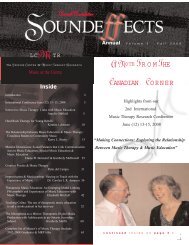Newsletter - Manfred and Penny Conrad Institute for Music Therapy ...
Newsletter - Manfred and Penny Conrad Institute for Music Therapy ...
Newsletter - Manfred and Penny Conrad Institute for Music Therapy ...
- No tags were found...
Create successful ePaper yourself
Turn your PDF publications into a flip-book with our unique Google optimized e-Paper software.
“Searching <strong>for</strong> milestones: The analysis of clinical improvisation<strong>for</strong> music therapy students <strong>and</strong> music therapists”Abstract: The research is intended to provide an opportunity<strong>for</strong> music therapists <strong>and</strong> music therapy students to be able toinspect where they are now, <strong>and</strong> also where they need to proceed,in order to possess <strong>and</strong> present an appropriately highlevel of proficiency in clinical improvisation. The research wasdesigned to analyze <strong>and</strong> compare the contents of clinicalimprovisation sessions collected from four interviewed participants<strong>for</strong> an educational purpose. The study investigated howmusic therapists <strong>and</strong> music therapy students perceive clinicalimprovisation, <strong>and</strong> sought to establish possible guidelines or criteria<strong>for</strong> successful clinical improvisation. The process of analysis<strong>and</strong> description was divided into two different levels: musicaldata analysis <strong>and</strong> verbal data analysis. The main focus of theresearch findings dealt with the critical analysis, not only from amusicological perspective, but also clinical perspective.Through the comparative analysis, the researcher found <strong>and</strong>discussed three significant points: 1) clinical improvisation as aclinical <strong>for</strong>m of communication 2) the use of vocalization in clinicalimprovisation as an effective <strong>and</strong> empathetic means of communication3) the correlation between clinical judgment <strong>and</strong>clinical listening <strong>and</strong> response. One of the unique qualities ofthe research content was to present solid in<strong>for</strong>mation in the<strong>for</strong>m of aurally transcribed musical analysis in addition to theverbal analysis from the interviews. The method of musicaldata analysis was adapted from that of Aesthetic <strong>Music</strong><strong>Therapy</strong> (AeMT) model (Lee, 2003)Sung-Yong Shim, MMTAbstract: This qualitative research study stemmed out of theresearcher’s quest to gain a deeper underst<strong>and</strong>ing of the therapeuticprocess in her music therapy practice. The analysis ofsessions with three individual clients using modified protocolanalysis <strong>and</strong> conceptions of grounded theory revealed five categoriesof themes present in the therapeutic interventions <strong>and</strong>relationships. Investigating the categories of expectation, invitation,challenge, being present, <strong>and</strong> validation led to a discoverythat the researcher-therapist’s value system, which was shapedby her life experiences, upbringing <strong>and</strong> culture, played a significantrole in the therapeutic process. Conducting this study hashelped the researcher to gain more awareness in both personal<strong>and</strong> professional aspects of her self, thereby contributing to thequality of her music therapy practice.Michelle Song, MMT“Burnout of operatic proportions: The impact of trauma on theexperience of burnout of Canadian <strong>Music</strong> Therapists”Abstract: The impact of unresolved personal trauma (Figley,1985) <strong>and</strong> unaddressed issues stemming from one’s family ororigin (Rompf & Royce, 1994) as well as workplace trauma(including trauma <strong>and</strong> vicarious traumatization) (Figley, 1985)impact on the experience of burnout in Canadian <strong>Music</strong>Therapists. In addition, workplace <strong>and</strong> professional factorssuch as a lack of supervision, debriefing <strong>and</strong> support, exacerbatethe experience of burnout as found in other helping professions(Cherniss, 1995). The dynamic <strong>and</strong> at times immediateprocess elicited in musical interventions (Lee, 2003) suggest adifferent therapeutic relationship from other helping professions.Therapist countertransference <strong>and</strong>/or vicarious traumatizationcan contribute to the experience of burnout, especially if thetherapist is lacking in study participant-identified skills such verbalinterventions <strong>and</strong> self-awareness (Rogers, 1992).Andrea Lamont, MMTAbstract: Introduction: Rap music <strong>and</strong> the aesthetics of HipHop culture represent a powerful, counter-cultural art <strong>for</strong>m thatis omni-present in the lives of members of contemporary youthculture. A weekly drop-in music therapy group was held <strong>for</strong> residentsof a youth shelter in Toronto. The most frequently usedclinical technique was clinical-improvisations in recognizablepopular music genres. Rap was the genre most frequentlyused. Mixed messages are imbedded in the culture of rapmusic as there are many examples of lyrics with anti-socialcontent <strong>and</strong> many examples of positive, potentially trans<strong>for</strong>mativelyrics. The positive <strong>and</strong> anti-social aspects of popular rapmusic were reflected in the sessions <strong>and</strong> resulted in clinicalchallenges <strong>and</strong> a rich body of recorded lyrics.Methods & Analysis: Clinical improvisations were recorded<strong>and</strong> lyrics transcribed verbatim. A qualitative, grounded theorymethod was used, to identify major themes. Major themeswere analyzed to determine what the potential, meaning of therap-therapy experience might be <strong>for</strong> the participants, <strong>and</strong> todetermine the therapeutic potential of this technique.Results: Major themes discovered in the lyrics closely paralleledverbal self-expression in psychotherapy. Participantsused the per<strong>for</strong>mance of rap to express emotions, spirituality,<strong>and</strong> vulnerability. The raps were also used to depicts threats<strong>and</strong> violence. Additionally strong connections were foundbetween the lyric analysis <strong>and</strong> a number of traditions in AfricanAmerican oral culture.Conclusions: The popularity, expressive power, <strong>and</strong> culturecontext of rap music combine to make it a potentially important<strong>and</strong> exciting resource <strong>for</strong> music therapists.Aaron Lightstone, MMTwww.wlu.ca99






